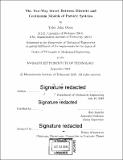The two-way street between discrete and continuum models of particle systems
Author(s)
Olsen, Tyler J. (Tyler John)
DownloadFull printable version (17.72Mb)
Other Contributors
Massachusetts Institute of Technology. Department of Mechanical Engineering.
Advisor
Ken Kamrin.
Terms of use
Metadata
Show full item recordAbstract
Many systems exhibit behavior across multiple length scales. When modeling the behavior of such systems, simplifying assumptions are commonly made to reduce model complexity while still capturing system behavior accurately at a length scale of interest. However, it can frequently be advantageous to explicitly incorporate information about a smaller length scale. We present two examples from diverse fields using this approach. First, we propose a model to describe the evolution of a flowing, microstructured suspension of conductive particles, which are being considered for use in large-scale energy storage technologies. In such a suspension, the microstructure of the contact network between particles gives rise to macroscopic electrical conductivity. Developing this model consists of two phases: 1) developing a discrete model for the conductivity of a simplified network, and 2) embedding the discrete model into the framework of modern continuum mechanics. The resulting model takes the form of a tensorial evolution law, like those typically seen in continuum constitutive relationships. The model has been validated experimentally and is able to predict both steady-state and transient conductivity more accurately than pre-existing models in the literature. The second application that we consider is the simulation of many-rigid- body systems. Treating stiff, elastic bodies in contact as perfectly rigid-an approach commonly referred to as Contact Dynamics (CD)-simplifies some aspects of their behavior and can alleviate considerable computational burden. However, in many cases the neglect of elasticity results in indeterminate systems, a problem that prevents CD from being used in many real-world applications. We show that information from elasticity can be re-introduced as a compatibility condition while retaining the assumption of perfect rigidity. This preserves the computational advantages of an optimization-based CD method. The new method is exact in the absence of friction and shows improved force calculation for frictional granular systems.
Description
Thesis: Ph. D., Massachusetts Institute of Technology, Department of Mechanical Engineering, 2018. Cataloged from PDF version of thesis. Includes bibliographical references (pages 175-184).
Date issued
2018Department
Massachusetts Institute of Technology. Department of Mechanical EngineeringPublisher
Massachusetts Institute of Technology
Keywords
Mechanical Engineering.